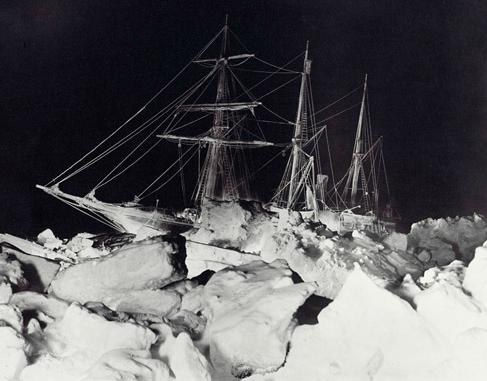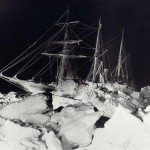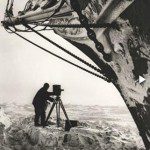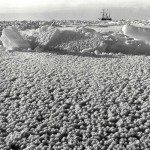Hurley’s Icy Images of Shackleton’s Trek at Ralls Collection
By • December 11, 2012 0 2218

If you’re dreaming of a white Christmas, you might wander over to the Ralls Collection before it’s too late.
You have until Dec. 15 to catch the exhibition, “The Photographs of Frank Hurley.” You want white—you’ve got white—the white of Antarctic ice, icebergs, ice floes and snow and blizzards, as endured by the men of 360-foot wooden ship Endurance, all part of a mission by English explorer Ernest Shackleton, who set sail for the Antarctic in August of 1914 with his crew and official photographer, an Australian by the name of Frank Hurley. They were leaving behind England and Europe, where World War I was just beginning.
Shackleton was attempting to become the first man to lead an expedition that would walk across the Antarctic from the Weddell to the Ross Sea. His expedition—named the Imperial Transantarctic Expedition—never accomplished that. Instead, the Endurance—it was named after a Shackleton family motto–was trapped in the ice along with the crew, which remained on the ship for a year until it sank. The men were then forced to live in what they managed to construct out of what was left of the lifeboats, subsisting on penguin and sea lion meat, until they were eating boiled bones. They moved to a barren island from which Shackleton set sail with five men on one of the lifeboats to try and reach a whaling station in the South Atlantic. After a harrowing 800-mile journey, he returned with help to rescue the rest of his crew, including Hurley. All of the members of the expedition survived.
Shackleton’s journey was a failure but in an age of brave exploration his survival and the rescue of his crew became a legendary story—a legend built on solid, black-and-white evidence that came with almost artful emotional content.
Marsha Ralls bought 35 of Hurley’s photos from the National Geographic Society 35 years ago and ended up keeping them. Hanging on the walls of her gallery in Georgetown, the images make an odd assemblage—they’re full of the kind of grandeur and stories that keep trying to escape the boundaries of their frames and edges. Each pictures seems to contain a frozen story.
Hurley was no stranger to the Antarctic, having accompanied Australian explorer Douglas Mawson on a trip to the Antarctic on the Nimrod. His photographic results led to his appointment on the Endurance.
The photographs in the Ralls exhibition appear to encompass the first year of the crew’s stay on the Endurance before it sank. The look is almost fantastic, like a visual tall tale, except, of course, that they’re real images, especially the photographs of the ship frozen in tundras of ice. The ship seems at once a powerful contraption and one totally in the grip of helplessness. Against the vast expanse of ice, the ship at times seems like a toy, the men working on the ice stick figures. Especially haunting is an image of the Endurance at night.
Hurley’s pictures—including one showing him draped across a mast, or underneath the ship, at work—are famous. There have been books about the expedition, stories and tales and pictures, all of which has elevated the failed expedition to the realm of legend. But it’s the pictures that tell the story, keep it alive in the mind as fact, a living fact of what men can endure, of how precious and powerful the earth is, we and the creatures in it (In one image, a group of king penguins seem to be in conference.).
According to stories about Hurley, he was a taciturn sort of Australian who was a doer, a great maker of pictures and also maker of makeshift environments —a dark room on the ship. He was without question brave—he dove into icy waters to save negatives, then returned from his ordeal with the expeditions to jump into the midst of World War I, chronicling the fortunes and misfortunes of the Australian troops in France and at the battle of Ypres.
“The Photographs of Frank Hurley” through Dec. 15 — The Ralls Collection, 1516 31st St., NW; 202-342-1298.
- Tim Riethmiller
- Nora Birch





